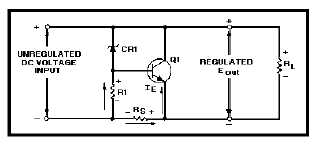34
Figure 4E.
Simple shunt voltage regulator.
IN ANSWERING QUESTIONS 4-50
THROUGH 4-52, REFER TO FIGURE 4-E.
4-50. The base-emitter bias across Q1 is
determined by which of the components?
1. R1 and CR1
2. R1 and RS
3. RS and CR1
4. RS and RL
4-51. What, if anything, happens to the
forward bias of Q1 when the input
voltage increases?
1. It increases
2. It decreases
3. Nothing, it remains the same
4-52. When the load current increases and the
output voltage momentarily drops, what,
if anything, happens to the resistance of
Q1?
1. It increases to compensate for the
drop
2. It decreases to compensate for the
change
3. Nothing, it remains the same
4-53. What type of ammeter reading indicates
that current regulator is functioning
properly?
1. Constant
2. Deflection in the negative direction
3. Deflection in the positive direction
4. Fluctuation around the center line
4-54. A major disadvantage of having good
current regulation is that good voltage
regulation is lost.
1. True
2. False
4-55. To maintain a constant current flow
when there is an increase in the load
resistance (RL), variable resistance (RV)
must compensate for this change by
1. increasing its resistance
2. decreasing its resistance
3. remaining the same
4-56. A decrease in the forward bias of a base-
emitter junction has which of the
following effects on the resistance of a
transistor?
1. It increases
2. It deceases
3. It remains the same
4-57. Voltage multipliers are used primarily to
develop what type of voltage?
1. Low voltage where low current is
required
2. Low voltage where high current is
required
3. High voltage where low current is
required
4. High voltage where high current is
required
4-58. The classification of voltage multipliers
depends on which of the following
ratios?
1. Input current to output current
2. Input current to output voltage
3. Output voltage to input voltage
4. Input voltage to output current

